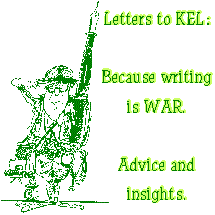Letters to Kel: FILLING IN THE WHITE SPACES
 Have you ever thought about all that white space on a standard screenplay page?
Have you ever thought about all that white space on a standard screenplay page?Why do they waste so much paper, indenting the dialogue on both sides, inserting parenthetical that are indented even more, in the dialogue?
Part of that is to help with estimating timing, to know how long the screenplay is going to be. Standard formatted screenplays translate to about 1 minute of screen time per page of script. Of course, there is some variation you have to allow for, depending on how much action there is versus how much dialogue. A long exchange of snappy one-liners between two or three characters, with not much else happening on camera, might take a lot less than one minute per page. And in an action-intensive movie, a single line, such as "Bandit's car races up the incline, dodging a long line of state trooper cars and jumps the river, hitting Buford's Cadillac with his back wheels as he lands," could take up two, three, four minutes on the screen -- depending on whether the director decided that scene needed to be done in slow motion to get all the impact he wanted.
So what is all that white space for, anyway? That's what YOU have to fill in, when you're translating your screenplay into a novel. Right now, I'm turning my screenplay originally titled "Walk the Wolf Trail" into CHARLI, the 6th book in my Quarry Hall series. The screenplay took up 100 pages on my computer when I uploaded it into Word. I'm 30 pages into the book now, and there are 116 pages -- so how did I gain 16 pages already? Especially considering those "extra" 16 pages are single-spaced and the lines go from margin to margin instead of maybe 20 characters wide in the center of the page.
I'm filling in the white space -- taking you inside the characters' heads and senses, showing you how they feel, what they're thinking, what sensory impressions they are experiencing. A line of script says, "Bright summer morning," as it sets the stage, but in the book, I can go on for a paragraph or two, describing the chill in the air, the dampness lingering from the storm the night before, the smell of mud, the sight of leaves scattered across the lawn, the scent of coffee brewing in the next room, the rumpled bed from the heroine's restless night, the books scattered across the office floor, where a gust of wind knocked a window open and pushed the books off the shelf. On and on. WHY describe the scene? To put the characters THERE in the middle of it, so they feel like they're there.
On a film set, the artistic director and the people in charge of props and costumes and sound effects and the set create everything for the audience to see -- you, as writer, are in essence fulfilling all those functions. You could just say, "Jasmine walked into the room," but your character would in essence be acting in a blank room. Would you sit through a movie where characters walked through empty rooms, no color, no sounds, no furniture, no props? Or worse -- a movie where things and people suddenly appeared a second before they were needed or someone had to join a conversation? I don't know about you, but I HATE books where you had no idea there were other people in the room until they entered the conversation, or you had no idea the characters were in the kitchen until someone reached over and poured himself a cup of coffee. You wouldn't watch a movie like that -- so don't make your readers endure a book like that.
FILL IN THE BLANK SPACES -- set the stage, fill in the details, let them know what your characters are feeling, seeing, smelling, hearing, tasting, thinking, remembering.
While all those details can be left to the director and the designers in a movie, that's your job now. Don't give your readers a boring movie. And while yes, it's a good thing to engage them so they use their imaginations when reading your book, it's a little disconcerting when readers imagine your heroine is a tiny, curly-haired blond with pixie-like features and a voice like a lark, but in an important scene she suddenly picks up and swings a broadsword weighing 200 pounds, and roars out a war cry that makes the rafters shake, and the hero shouts to his sidekick, "Who is that raven-haired Amazon covered in blue and scarlet tattoos?"
Some surprises are good for readers, but not when your story constantly conflicts with the images they're been painting in their imaginations because YOU didn't give them any details. This is YOUR playground they've been invited into, and YOUR imagination movie they're watching. Make sure they see and hear and taste and smell and feel and experience the emotions and memories and thoughts that YOU did, when you wrote the story. NO BLANK SPACES, PLEASE!
Published on December 04, 2014 02:00
No comments have been added yet.



